Why do you decide in favor of certain actions and behavior over others? Several learning models have been developed in psychology to better understand and explain this behavior. Classical and operant conditioning, learning by self-control, and observational learning are important foundations that form the bases of psychotherapy. In addition to presenting facts about learning, this article discusses topics on memory and language that are relevant to your exam.
Last updated: Apr 4, 2023
Contents
The founder of the principle of classical conditioning, Ivan Pavlov (1849–1936), discovered the reaction-stimulus chain, which is the so-called respondent model. He combined the action of feeding dogs with the sound of a bell and discovered that eventually, the dogs salivated merely by hearing the bell, even without the sight of food.
The originally unconditioned stimulus (food) that led to an unconditioned reaction (salivation) was combined with a neutral impulse (sound of the bell). Over time, this neutral impulse triggered an unconditioned reaction and gradually became the conditioned stimulus.
A conditioned reaction can also be deleted (become extinct) by leaving out the conditioned impulse. The deleted reaction can reappear if the impulse is reintroduced; however, the reaction would be in a milder form (spontaneous recovery).
If similar impulses have the same reaction, they can be referred to as stimulus generalization. However, the term stimulus discrimination is reserved for when similar impulses can be distinguished.
| Factors affecting classical conditioning | ||||
| Neutral stimulus | Unconditioned stimulus | Unconditioned response | Conditioned stimulus | Conditioned response |
| Initially, does not elicit an intrinsic response | Will elicit an unconditioned response | Not learned, more biological | Originally neutral stimulus that is paired with an unconditioned stimulus | Learned response to the conditioned stimulus |

Classical conditioning includes the following steps:
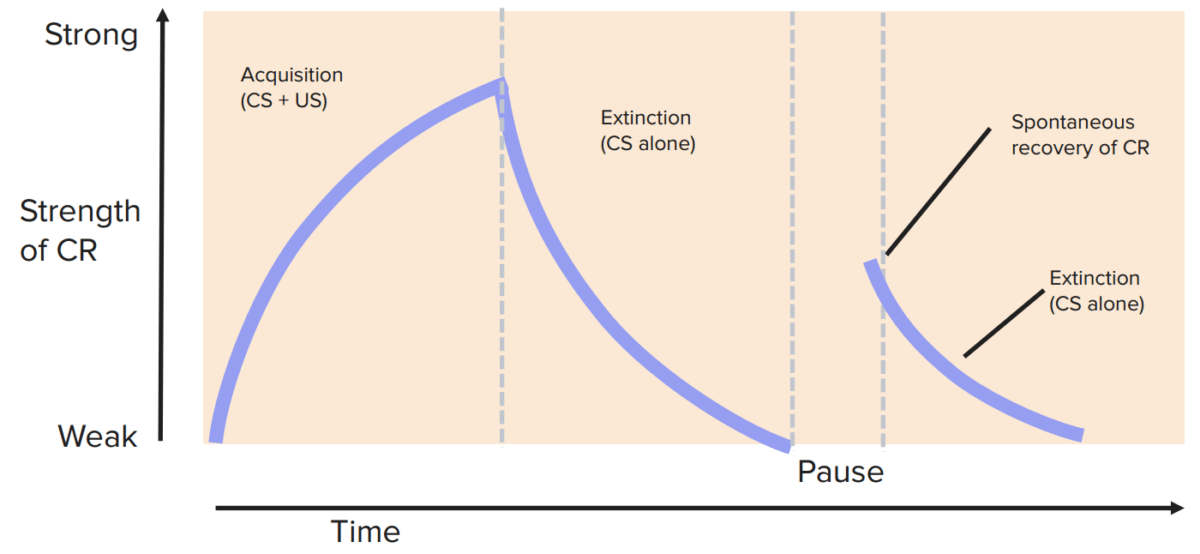
The American psychologist B.F. Skinner (1904–1990) is inevitably associated with the term operant conditioning Operant conditioning Learning situations in which the sequence responses of the subject are instrumental in producing reinforcement. When the correct response occurs, which involves the selection from among a repertoire of responses, the subject is immediately reinforced. Psychotherapy. In operant conditioning Operant conditioning Learning situations in which the sequence responses of the subject are instrumental in producing reinforcement. When the correct response occurs, which involves the selection from among a repertoire of responses, the subject is immediately reinforced. Psychotherapy, organisms associate their own actions with consequences. An action followed by a positive reinforcer (reward) increases that action, whereas an action followed by punishment tends to decrease the frequency of that action. Behavior that operates on the environment to produce rewarding or punishing stimuli is called operant behavior. During the acquisition of stimulus-reaction patterns, the question is: How do we adjust our originally spontaneous behavior through reward and punishment?
The following terms are important in operant conditioning Operant conditioning Learning situations in which the sequence responses of the subject are instrumental in producing reinforcement. When the correct response occurs, which involves the selection from among a repertoire of responses, the subject is immediately reinforced. Psychotherapy:
Warning:
Skinner box: an experimental setup with a fixed lever used for animal studies. If the lever is pushed, the rat is rewarded with a food pill for its behavior. The behavior of the rat (pushing down the lever) is reinforced; thus, the action is executed more often. If the rat receives a painful stimulus after pushing the lever, it will soon stop the behavior.
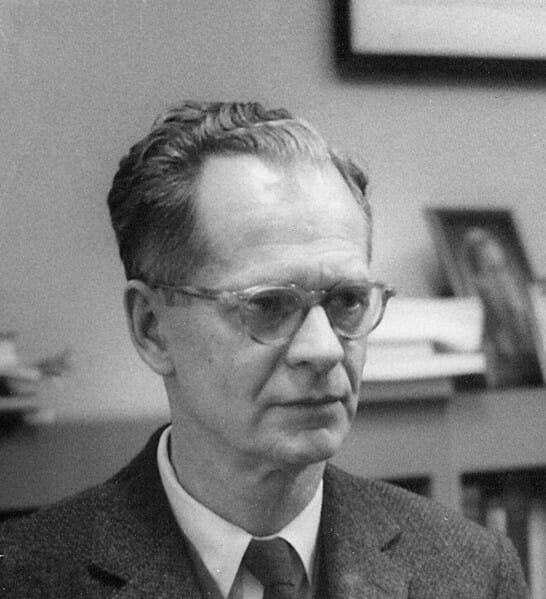
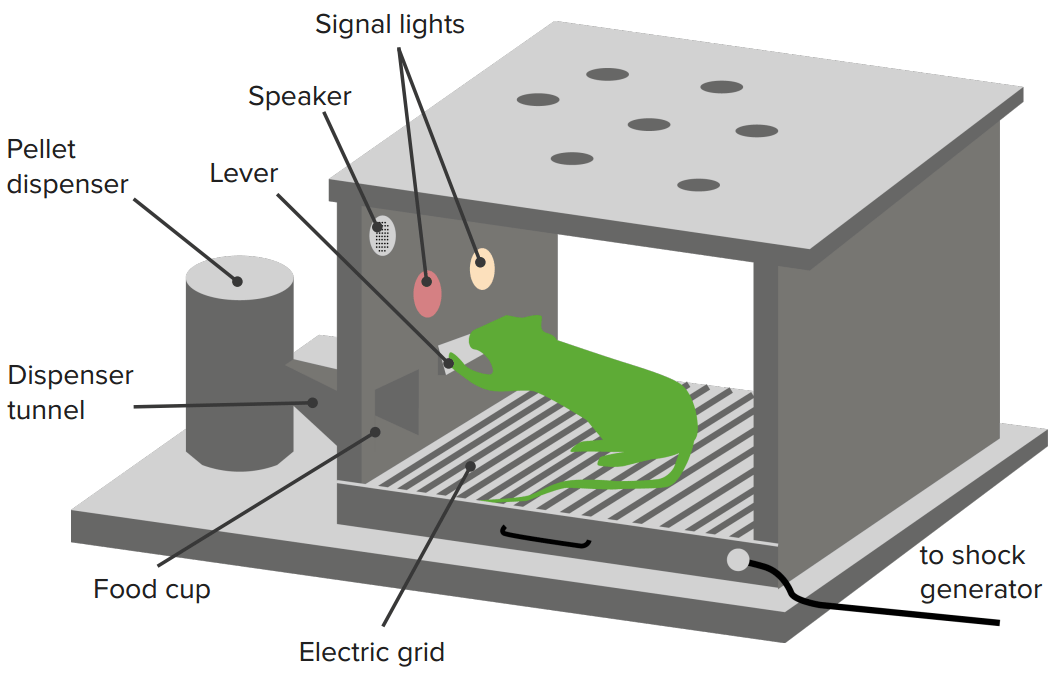
| … added | … removed | |
| Positive reinforcement Positive reinforcement Psychotherapy | Positive strengthening (behavior increases) | Punishment (behavior decreases) |
| Negative reinforcement Negative reinforcement Psychotherapy | Punishment (behavior decreases) | Negative strengthening (behavior increases) |
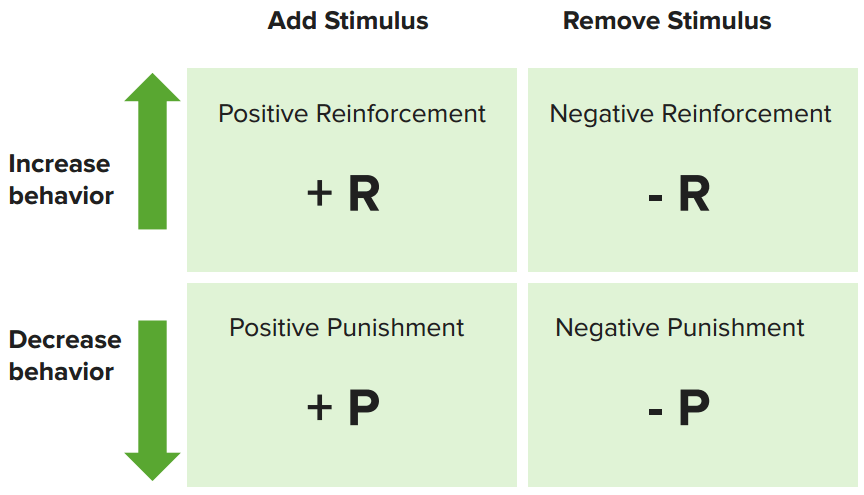
| Escape Escape With constant immune mechanisms holding unstable tumor cells in equilibrium, tumor-cell variants may emerge. These cancer cells may express fewer antigens on their surfaces or lose their MHC class I expression.Variants may also protect themselves from T-cell attack via expression of IC molecules on their surfaces, like normal cells.Creation of an immunosuppressive state in the microenvironment is another way to grow without immunologic interference. Cancer Immunotherapy | Avoidance |
| Learning how to avoid an aversive stimulus by engaging in a particular behavior | Performing a behavior to ensure that the aversive stimulus is not encountered |
| Term | Definition | Example |
|---|---|---|
| Primary reinforcement | Satisfaction of primary needs | Food, sleep Sleep A readily reversible suspension of sensorimotor interaction with the environment, usually associated with recumbency and immobility. Physiology of Sleep, rest |
| Secondary reinforcement | Linking to primary reinforcement (social, material) | Praise, admiration, money |
| Emitted behavior | Spontaneously occurring behavior that can be reinforced | Dog lifts its paw, gets rewarded, and repeats the behavior. |
| Prompting | Cue through initiating behavior externally | Learning a language |
| Fading | Gradual fading out of prompts throughout the conditioning process | A teacher gives tips to get the right answer and gradually reduces the number of tips during the process. |
| Shaping | Stepwise acquisition of complex behaviors by rewarding the consequences | A toddler learning to tie his shoelaces |
| Chaining | Learning complex chains of behavior; usually, the last element is reinforced 1st | Brushing teeth Teeth Normally, an adult has 32 teeth: 16 maxillary and 16 mandibular. These teeth are divided into 4 quadrants with 8 teeth each. Each quadrant consists of 2 incisors (dentes incisivi), 1 canine (dens caninus), 2 premolars (dentes premolares), and 3 molars (dentes molares). Teeth are composed of enamel, dentin, and dental cement. Teeth: Anatomy: toothpaste on the brush, clean various areas, gargle, use dental floss |
| Premack principle | Linking a less favorable activity with a popular one | “First, you have to eat the salad; then, you’ll get dessert!” |
Reinforcement plans are consistent relations between behavior and consequence that result in contingency.
High contingency is a given when almost every behavior results in a consequence. However, low contingency is expected when consequences follow only occasionally. Continuous reinforcement means that every single desired behavior is strengthened. Intermittent reinforcement means that only a certain number of all desired behavior is strengthened. A distinction is drawn between ratio plans and interval plans as tabulated below.
| Fixed ratio plans | Consequence after a fixed rate, e.g., every 3rd time |
| Variable Variable Variables represent information about something that can change. The design of the measurement scales, or of the methods for obtaining information, will determine the data gathered and the characteristics of that data. As a result, a variable can be qualitative or quantitative, and may be further classified into subgroups. Types of Variables ratio plans | Consequence after a variable Variable Variables represent information about something that can change. The design of the measurement scales, or of the methods for obtaining information, will determine the data gathered and the characteristics of that data. As a result, a variable can be qualitative or quantitative, and may be further classified into subgroups. Types of Variables rate, e.g., after the 2nd, then the 5th, then the 10th time |
| Fixed interval plans | Consequence after a fixed time interval, e.g., every 5 minutes |
| Variable Variable Variables represent information about something that can change. The design of the measurement scales, or of the methods for obtaining information, will determine the data gathered and the characteristics of that data. As a result, a variable can be qualitative or quantitative, and may be further classified into subgroups. Types of Variables interval plans | Consequence after a variable Variable Variables represent information about something that can change. The design of the measurement scales, or of the methods for obtaining information, will determine the data gathered and the characteristics of that data. As a result, a variable can be qualitative or quantitative, and may be further classified into subgroups. Types of Variables time interval, e.g., after 5 minutes, then after 10 minutes, and then after 15 minutes |
Important: While continuous reinforcement leads to the rapid learning of a behavior, behaviors are more resistant to erasure if reinforcement occurs intermittently and with a variable-ratio schedule (this may help explain the addictive-type behavior of gamblers).
While learning by understanding, we come to a solution by understanding the circumstances. Hence, an individual arrives at a solution through pure reflection and not through an outward visible and observable experience. The “lightbulb moment” falls in this category of learning by understanding: A sudden flash of inspiration Inspiration Ventilation: Mechanics of Breathing leads to understanding and solution-oriented behavior. This approach can be extrapolated to other situations (e.g., a mathematics problem).
Note: Observational learning is a type of cognitive learning and is also known as social learning or vicarious learning.
Behavior is learned with potentially positive or negative consequences using a model. Other people are observed and their behavior is imitated and learned accordingly. Consequently, there is neither reinforcement nor consequence for the observer.
Many pro- and antisocial behaviors become conceivable through observational learning.
Examples:
Mirror neurons Neurons The basic cellular units of nervous tissue. Each neuron consists of a body, an axon, and dendrites. Their purpose is to receive, conduct, and transmit impulses in the nervous system. Nervous System: Histology are found in several regions of the brain Brain The part of central nervous system that is contained within the skull (cranium). Arising from the neural tube, the embryonic brain is comprised of three major parts including prosencephalon (the forebrain); mesencephalon (the midbrain); and rhombencephalon (the hindbrain). The developed brain consists of cerebrum; cerebellum; and other structures in the brain stem. Nervous System: Anatomy, Structure, and Classification, including:
These neurons Neurons The basic cellular units of nervous tissue. Each neuron consists of a body, an axon, and dendrites. Their purpose is to receive, conduct, and transmit impulses in the nervous system. Nervous System: Histology fire when a task is performed and/or when that same task is observed. They help us understand the actions of others and assist in learning through imitation. They are also potentially responsible for the learning of vicarious emotions such as empathy Empathy An individual’s objective and insightful awareness of the feelings and behavior of another person. It should be distinguished from sympathy, which is usually nonobjective and noncritical. It includes caring, which is the demonstration of an awareness of and a concern for the good of others. Psychotherapy.
Behaviors are learned by initial model-based learning and operant conditioning Operant conditioning Learning situations in which the sequence responses of the subject are instrumental in producing reinforcement. When the correct response occurs, which involves the selection from among a repertoire of responses, the subject is immediately reinforced. Psychotherapy. We create our expectation patterns for ourselves accordingly. The intrinsic factors of self-control, self-criticism, and self-confirmation now replace outside reinforcement and punishment.
Example: A child is taught that leisure activities can only be enjoyed after achieving something. As adults, these individuals take a break only when their self-imposed work plans for the day are met MET Preoperative Care.
| Habituation | Adaptation to a recurrent impulse: The intensity of reaction decreases with repetition (though no habituation to pain Pain An unpleasant sensation induced by noxious stimuli which are detected by nerve endings of nociceptive neurons. Pain: Types and Pathways). | Contact lenses, tactile impulses of clothing |
|---|---|---|
| Dehabituation | “Weaning from habituation”: recurrence of the reaction after habituation through an interspersed, different impulse | If the permanent siren sound of an ambulance suddenly changes, we notice the already faded out sound again. |
| Sensitization | Opposite of habituation: an increase in reaction intensity, which increases with repetition |
The elaboration likelihood model is a dual-process theory describing changes in attitude and behavior.
| Message characteristics | Source characteristics | Target characteristics |
|---|---|---|
| Logic and number of key points, length, and grammatical complexity | Level of expertise, knowledge, and trustworthiness | Self-esteem, intelligence, and mood (of the individual receiving the message) |
The model proposes 2 major routes for persuasion:
Individuals will choose the central route only when they are both motivated and not distracted. Processing via the central route will have longer-lasting persuasion compared with that via the peripheral route.
The social-cognitive theory incorporates elements of cognition, learning, and social influence. It is a theory of behavioral change that emphasizes the interaction between people and their environment. Social factors, observational learning, and environmental factors can influence attitude change.
Reciprocal determination is an interaction between an individual’s behavior, personal factors, and the environment (situational factors). The 3 ways in which individuals and environments interact are as follows:
Behavior therapy is used especially in the case of anxiety Anxiety Feelings or emotions of dread, apprehension, and impending disaster but not disabling as with anxiety disorders. Generalized Anxiety Disorder disorders ( phobia Phobia A phobia can be defined as an irrational fear that results in avoidance of the feared subject, activity, or situation. Social Anxiety Disorder). Classical conditioning processes play a major role in the development of fear, whereas sustainability is achieved by operant conditioning Operant conditioning Learning situations in which the sequence responses of the subject are instrumental in producing reinforcement. When the correct response occurs, which involves the selection from among a repertoire of responses, the subject is immediately reinforced. Psychotherapy. The linking of stimulus and reaction (such as the fear of black cars winding up in an accident) can be prevented for years by avoiding the anxiety-inducing stimulus.
A therapist will create an analysis of behavior using the “SORCC model,” e.g., the fear of black cars.
Systematic desensitization Systematic desensitization A behavior therapy technique in which deep muscle relaxation is used to inhibit the effects of graded anxiety-evoking stimuli. Psychotherapy
Systematic desensitization Systematic desensitization A behavior therapy technique in which deep muscle relaxation is used to inhibit the effects of graded anxiety-evoking stimuli. Psychotherapy describes a procedure in the following 3 steps:
Flooding Flooding Psychotherapy
Stimulus saturation is not a stepwise process. It involves a sudden, intense confrontation with the object/situation of fear. Flooding Flooding Psychotherapy proves to the afflicted individual that no real danger can be caused by the stimulus.
Cognition is perceived (Latin. cognoscere = experience, recognize) as a complex comprising perception Perception The process by which the nature and meaning of sensory stimuli are recognized and interpreted. Psychiatric Assessment, consciousness, thinking, recognition, and memory Memory Complex mental function having four distinct phases: (1) memorizing or learning, (2) retention, (3) recall, and (4) recognition. Clinically, it is usually subdivided into immediate, recent, and remote memory. Psychiatric Assessment.
Attention Attention Focusing on certain aspects of current experience to the exclusion of others. It is the act of heeding or taking notice or concentrating. Psychiatric Assessment: heightened vigilance and selective focus of perception Perception The process by which the nature and meaning of sensory stimuli are recognized and interpreted. Psychiatric Assessment, thinking, and action = condition of intense consciousness
Perception Perception The process by which the nature and meaning of sensory stimuli are recognized and interpreted. Psychiatric Assessment: We gain information about the outer and inner worlds through perception Perception The process by which the nature and meaning of sensory stimuli are recognized and interpreted. Psychiatric Assessment. Exteroception is the term for the perception Perception The process by which the nature and meaning of sensory stimuli are recognized and interpreted. Psychiatric Assessment of the environment through the senses, whereas interoception refers to the inner perception Perception The process by which the nature and meaning of sensory stimuli are recognized and interpreted. Psychiatric Assessment of physiological processes.
Perception Perception The process by which the nature and meaning of sensory stimuli are recognized and interpreted. Psychiatric Assessment can be selective, strengthened, subliminal, or impaired. Perception Perception The process by which the nature and meaning of sensory stimuli are recognized and interpreted. Psychiatric Assessment disorders include the following:
A classic model used to describe the human memory Memory Complex mental function having four distinct phases: (1) memorizing or learning, (2) retention, (3) recall, and (4) recognition. Clinically, it is usually subdivided into immediate, recent, and remote memory. Psychiatric Assessment system is the information-processing model, which is similar to the functions of a computer. To remember any event, we must do the following 3 things:
Like any other model, the information-processing model is useful but has some limitations Limitations Conflict of Interest. We are capable of parallel processing, and the model of connectionism considers memories as derivations or products of interconnected neural networks. Every time we learn something new or recall a stored memory Memory Complex mental function having four distinct phases: (1) memorizing or learning, (2) retention, (3) recall, and (4) recognition. Clinically, it is usually subdivided into immediate, recent, and remote memory. Psychiatric Assessment, we create new neural connections that strengthen the neural pathways.
The process of memory Memory Complex mental function having four distinct phases: (1) memorizing or learning, (2) retention, (3) recall, and (4) recognition. Clinically, it is usually subdivided into immediate, recent, and remote memory. Psychiatric Assessment formation has been explained by another classic, although imperfect, 3-stage model:
Episodic memory Memory Complex mental function having four distinct phases: (1) memorizing or learning, (2) retention, (3) recall, and (4) recognition. Clinically, it is usually subdivided into immediate, recent, and remote memory. Psychiatric Assessment is defined as the ability to recall and mentally re-experience specific episodes from the past.
Semantic memory Memory Complex mental function having four distinct phases: (1) memorizing or learning, (2) retention, (3) recall, and (4) recognition. Clinically, it is usually subdivided into immediate, recent, and remote memory. Psychiatric Assessment is the memory Memory Complex mental function having four distinct phases: (1) memorizing or learning, (2) retention, (3) recall, and (4) recognition. Clinically, it is usually subdivided into immediate, recent, and remote memory. Psychiatric Assessment for generic, context-free knowledge.
| Anterograde amnesia Anterograde amnesia Loss of the ability to form new memories beyond a certain point in time. This condition may be organic or psychogenic in origin. Organically induced anterograde amnesia may follow craniocerebral trauma; seizures; anoxia; and other conditions which adversely affect neural structures associated with memory formation (e.g., the hippocampus; fornix (brain); mammillary bodies; and anterior thalamic nuclei). Wernicke Encephalopathy and Korsakoff Syndrome | A type of memory Memory Complex mental function having four distinct phases: (1) memorizing or learning, (2) retention, (3) recall, and (4) recognition. Clinically, it is usually subdivided into immediate, recent, and remote memory. Psychiatric Assessment loss in which new memories cannot be formed. If severe, the ability to learn or retain any new information is permanently lost. |
|---|---|
| Retrograde amnesia Retrograde amnesia Loss of the ability to recall information that had been previously encoded in memory prior to a specified or approximate point in time. This process may be organic or psychogenic in origin. Organic forms may be associated with craniocerebral trauma; cerebrovascular accidents; seizures; dementia; and a wide variety of other conditions that impair cerebral function. Wernicke Encephalopathy and Korsakoff Syndrome | A type of amnesia in which memories formed before the event that caused the amnesia cannot be recalled. It usually affects recently stored memories, and not memories from years ago. |
| Dissociative amnesia Dissociative amnesia Dissociative amnesia is a dissociative disorder characterized by temporary memory gaps in response to stressful events. Dissociative amnesia can be subclassified as generalized versus localized or continuous versus systematized. Dissociative Amnesia | Occurs when an individual blocks out certain information, e.g., information associated with a stressful or traumatic event Traumatic event An emotionally painful, shocking, stressful, and sometimes life-threatening experience. It can result from witnessing distressing events such as natural disasters, physical or sexual abuse, and terrorism or other acts of violence. Posttraumatic Stress Disorder (PTSD), such that they are unable to remember important personal information. There are gaps in memory Memory Complex mental function having four distinct phases: (1) memorizing or learning, (2) retention, (3) recall, and (4) recognition. Clinically, it is usually subdivided into immediate, recent, and remote memory. Psychiatric Assessment for prolonged periods of time, or memory Memory Complex mental function having four distinct phases: (1) memorizing or learning, (2) retention, (3) recall, and (4) recognition. Clinically, it is usually subdivided into immediate, recent, and remote memory. Psychiatric Assessment gaps involving the traumatic event Traumatic event An emotionally painful, shocking, stressful, and sometimes life-threatening experience. It can result from witnessing distressing events such as natural disasters, physical or sexual abuse, and terrorism or other acts of violence. Posttraumatic Stress Disorder (PTSD). |
Language and speech are used for interpersonal communication Communication The exchange or transmission of ideas, attitudes, or beliefs between individuals or groups. Decision-making Capacity and Legal Competence of thoughts, desires, and feelings. The Broca and Wernicke areas in the brain Brain The part of central nervous system that is contained within the skull (cranium). Arising from the neural tube, the embryonic brain is comprised of three major parts including prosencephalon (the forebrain); mesencephalon (the midbrain); and rhombencephalon (the hindbrain). The developed brain consists of cerebrum; cerebellum; and other structures in the brain stem. Nervous System: Anatomy, Structure, and Classification are responsible for language generation and speech comprehension, respectively. Central aphasia Aphasia A cognitive disorder marked by an impaired ability to comprehend or express language in its written or spoken form. This condition is caused by diseases which affect the language areas of the dominant hemisphere. Clinical features are used to classify the various subtypes of this condition. General categories include receptive, expressive, and mixed forms of aphasia. Ischemic Stroke is a speech disorder. Both speech comprehension and language production are impaired in global aphasia Aphasia A cognitive disorder marked by an impaired ability to comprehend or express language in its written or spoken form. This condition is caused by diseases which affect the language areas of the dominant hemisphere. Clinical features are used to classify the various subtypes of this condition. General categories include receptive, expressive, and mixed forms of aphasia. Ischemic Stroke.
| Function | Affected area of the brain Brain The part of central nervous system that is contained within the skull (cranium). Arising from the neural tube, the embryonic brain is comprised of three major parts including prosencephalon (the forebrain); mesencephalon (the midbrain); and rhombencephalon (the hindbrain). The developed brain consists of cerebrum; cerebellum; and other structures in the brain stem. Nervous System: Anatomy, Structure, and Classification | Type of aphasia Aphasia A cognitive disorder marked by an impaired ability to comprehend or express language in its written or spoken form. This condition is caused by diseases which affect the language areas of the dominant hemisphere. Clinical features are used to classify the various subtypes of this condition. General categories include receptive, expressive, and mixed forms of aphasia. Ischemic Stroke | |
|---|---|---|---|
| Broca area | Language production (speaking) | Frontal Frontal The bone that forms the frontal aspect of the skull. Its flat part forms the forehead, articulating inferiorly with the nasal bone and the cheek bone on each side of the face. Skull: Anatomy convolutions of the dominant hemisphere (on the left side for right-handed individuals) | Motor Motor Neurons which send impulses peripherally to activate muscles or secretory cells. Nervous System: Histology, expressive aphasia Expressive aphasia An aphasia characterized by impairment of expressive language (speech, writing, signs) and relative preservation of receptive language abilities (i.e., comprehension). This condition is caused by lesions of the motor association cortex in the frontal lobe (broca area and adjacent cortical and white matter regions). Geriatric Changes (Speech comprehension is intact; familiar songs can be sung.) |
| Wernicke area | Speech comprehension | Usually involves the posterior region of the superior temporal gyrus of the dominant hemisphere, but may also extend into the adjacent parietal lobe Parietal lobe Upper central part of the cerebral hemisphere. It is located posterior to central sulcus, anterior to the occipital lobe, and superior to the temporal lobes. Cerebral Cortex: Anatomy | Sensory Sensory Neurons which conduct nerve impulses to the central nervous system. Nervous System: Histology, recipient aphasia Aphasia A cognitive disorder marked by an impaired ability to comprehend or express language in its written or spoken form. This condition is caused by diseases which affect the language areas of the dominant hemisphere. Clinical features are used to classify the various subtypes of this condition. General categories include receptive, expressive, and mixed forms of aphasia. Ischemic Stroke (impaired speech comprehension) |
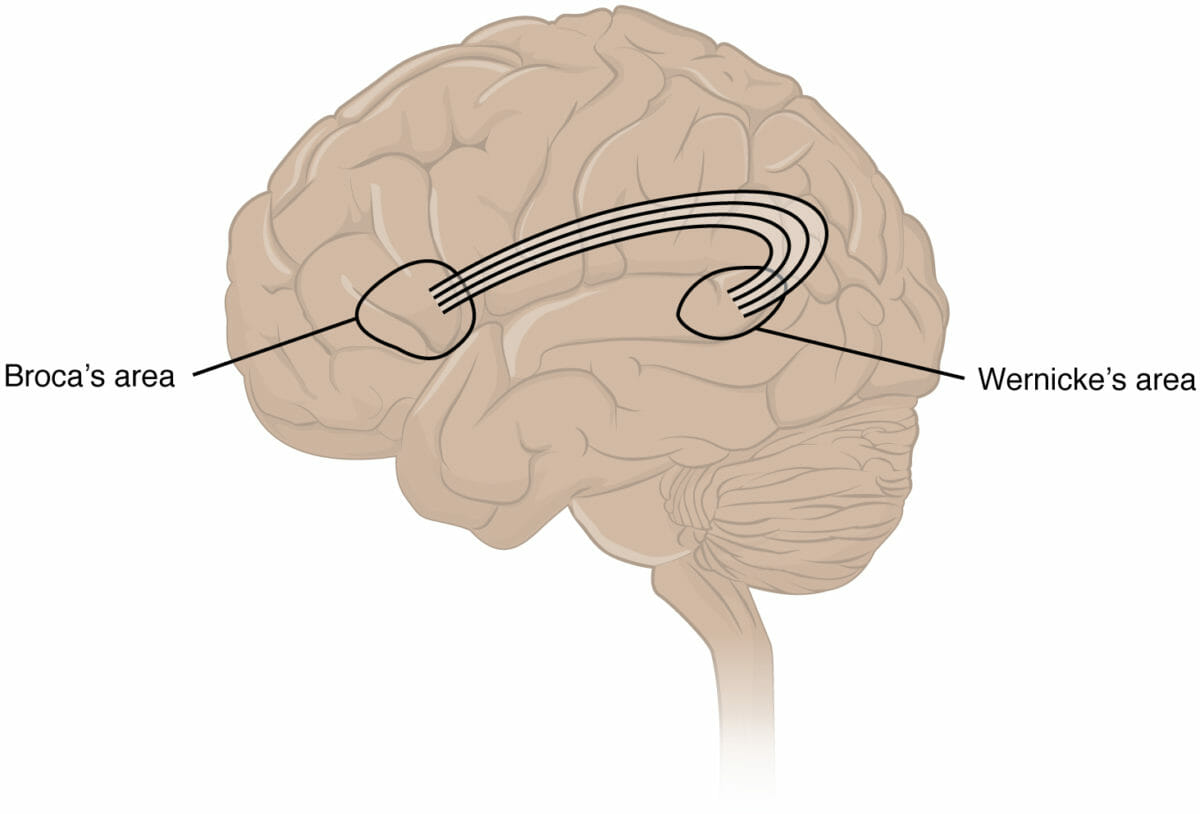
Language acquisition is the process by which children learn to understand and speak their native language. Theories used to explain language development include the following:
Nativist theory by Noam Chomsky
Empiricist
Behaviorist theory by B.F. Skinner
Positive reinforcement Positive reinforcement Psychotherapy accomplishes the following:
| Month (approximate) | Stage |
|---|---|
| 4 | Babbles speech sounds (“ah-goo”) |
| 10 | Babbling resembles household language (“ma-ma”) |
| 12 | One-word speech (“Kitty!”) |
| 24 | Two-word speech (“Get ball”) |
| 24+ | Rapidly starts to speak complete sentences |